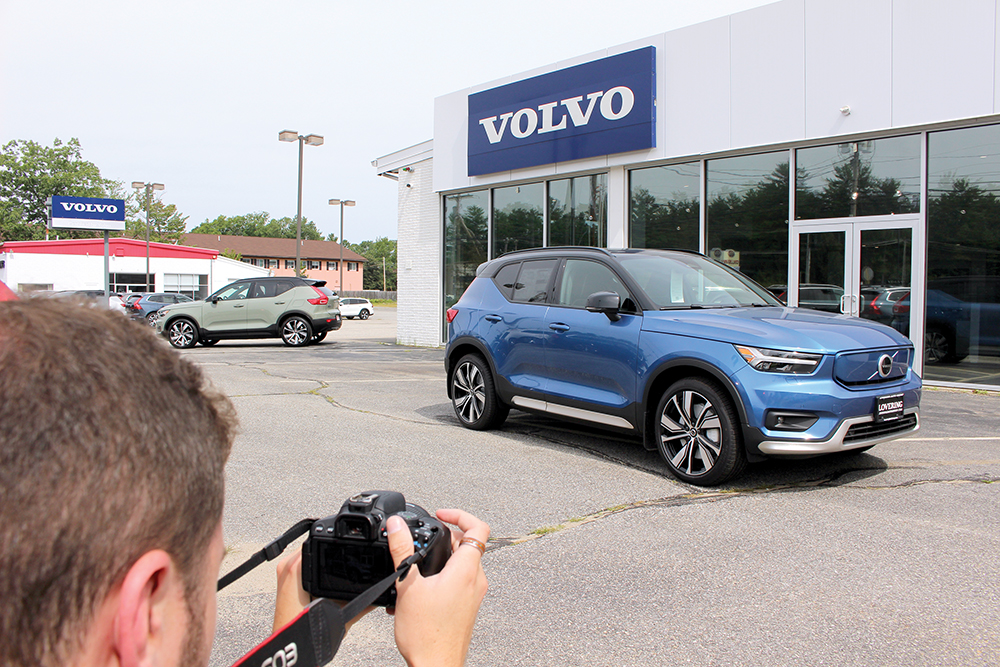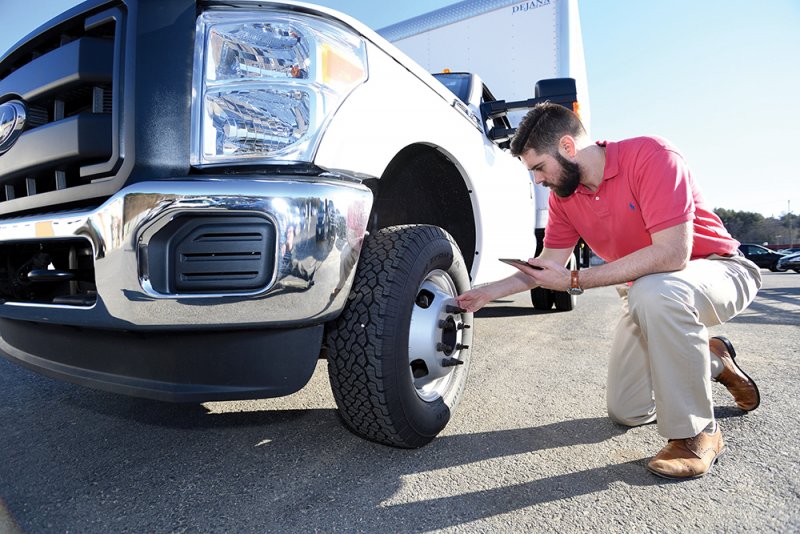 An employee photographs a vehicle at Lovering Auto Group. Courtesy photo.
An employee photographs a vehicle at Lovering Auto Group. Courtesy photo.
At a time of unprecedented demand for new vehicles, a global chip shortage has auto dealers scrambling to serve customers and find new ways of doing business.
According to Autoweek, the chip shortage is rooted in the early part of the pandemic when the automakers largely shut down, and chip suppliers turned to computers and gaming. When the auto sector ramped back up, the chip makers couldn’t simply drop the electronics contracts.
Pete McNamara, president of the NH Automobile Dealers Association, which represents more than 500 motor vehicle-related businesses in the state, says the shortage is likely to last another 12 to 18 months.
“The big headache is the supply chain disruptions; it began with COVID and continued with workforce shortages from suppliers around the world,” he says.
McNamara says at least one major manufacturer was looking at placing vehicles at dealerships so they will be in place when the chips are ready, which can be shipped to dealers and installed by local technicians.
Amanda Grappone Osmer, a fourth-generation owner of Grappone Automotive Group in Bow, says they have more cars than they did a month ago and a lot to offer as they sell Toyota, Honda, Mazda, Ford and Hyundai. But she says they are still only carrying about 15% to 20% of normal inventory.
“From a business standpoint, it is not so bad for us to not have cars that people are not buying,” says Osmer. “Under the normal model, we would have many millions of dollars in inventory just sitting on the lot that we have to pay interest on. It is tougher on consumers though because they have fewer choices. A lot of what comes in off of a truck would typically be fresh inventory. … [N]ow stuff is sold as it is coming in.”
Vanessa Delegas, president of Lovering Auto Group, with Volvo dealerships in Nashua, Concord and Meredith, says they too have experienced low supply of new and used inventory. “I am on the New Hampshire Auto Dealers Association board, and everyone is in a similar situation today with inventory. We have all gotten used to selling with a lower days-of-supply of inventory.”
She says it varies by manufacturer, though Volvo did pretty well for a while. “Our shortages were mainly due to increased demand that the manufacturer did not anticipate for this year, but no one knew what to expect. Volvo was one of the few brands that actually saw an increase in sales from 2019 to 2020.”
At Crest Auto World in North Conway, where they sell Chevrolet, Chrysler, Dodge, Jeep and Ram vehicles, Christopher Weiss, president, says the shortages have been a big challenge. “Heavy-duty Chevrolet trucks and Jeep Wranglers are the really hot models. Anyone looking to buy those has experienced just how challenging it is to find what you are looking for.”
Service While you Wait? Maybe Not
With fewer new cars available, people are pouring disposable income into fixing older models. The demand for service is up, and with delays for parts, customers are looking for those courtesy loaner cars to keep them on the road.
“We have increased our loaner fleet for service orders as we have seen a large demand in appointments,” says Delegas of Lovering. “We are also in the middle of a model year change over, so some dealers are opting not to increase loaners because there is too much demand from sales, so some are having customers wait multiple weeks for an appointment.”
She adds that after diagnosing a problem, the technicians, who may have been able to get that part overnight, now are sometimes having to wait several days.
A Perfect Storm
At Merchants Automotive Group in Hooksett, which includes Merchants Fleet and Merchants Auto, the effect of the supply chain disruption is a little different, says Adam Secore, senior vice president of operations. He says because Merchants Fleet provides vehicles to companies all over the nation, it puts Merchants Auto in a unique position. “While many local dealers are struggling to find inventory or even closing, Merchants Auto has a steady flow from the Fleet segment putting us in a much better position than most dealerships even nationally,” he says.

A Merchants Fleet employee works on a truck. Courtesy photo.
Secore says the Fleet had early insights into the supply chain problems. “On the Fleet side of the business we buy factory direct, and therefore we knew a year ago they were starting to have issues in manufacturing,” says Secore.
He adds, prior to the shortages, Merchants Auto always received its portion of the fleet when leases expired, and those vehicles, primarily from Fleet clients in the Northeast, would be brought to Hooksett. “Given the supply chain issues, now all of Fleet’s inventory across the country is coming back to Hooksett,” he says.
Meanwhile, another strategic move has paid off. At a time when everyone was staying home and getting everything delivered, Merchants Auto launched a commercial division, selling used cargo vans for last mile delivery.
“It was the perfect storm,” says Secore. “On the fleet side of the business, we had experiences with commercial accounts and we had the vehicles coming off of leases from all over the country. We saw the need and grew the Commercial Sales division. Demand is off the charts, and I don’t believe it will slow down with so many people who can’t get their brand-new vehicles.”
He says Merchants Auto is gaining a national reach, especially the commercial division. “People are flying in from Texas, Florida and Philadelphia,” says Secore. “Merchants has the cars, and that is the game right now.”
Pot of Gold in Your Garage
“For consumers it can be a great time to sell,” says Delegas. “If you have a second car you don’t need, this is the only time I have ever seen when you can make money on your car.”
Osmer agrees. She says the used car market is tied directly to the new car market; therefore, it is just harder to get anything right now. “If you get flyers in the mail or hear a dealership on the radio saying, ‘sell us your used car,’ it’s no joke; everybody is looking for used inventory.”
She says even if someone doesn’t think they are in an equity position, check it out. “Find out what your car is worth versus what you owe on it, and you might be pleasantly surprised. Just keep in mind you want to have a vehicle to replace it with,” Osmer says.
Auto pricing platforms, such as Kelley Blue Book, Galves and Edmunds may lag behind, Osmer says, which means the price dealers are willing to pay for used cars may be higher.
“We have software that is helpful in showing exactly how many vehicles are available in a set radius, how many miles are on the vehicle and the trim level. We can see if the market is flooded or in short supply. It is quite a science that goes into how to value a trade,” Osmer says.
Light at the End of the Tunnel
Weiss says he is hopeful the supply chain problems will ease up by 2022. “Maybe we will start to see inventories ramp back up after the first of the year, but it seems like that position changes every day. Some say it may only be a month or two, but, based on experience, I’m not confident. Once the chip shortage is squared away, what other challenges may be lurking out there because they haven’t been able to manufacture at full tilt?”
Delegas says she too hasn’t got a clear sense on when things will improve. “The semiconductor microchip shortage is changing almost daily from what I’m hearing from Volvo. They have been pretty quiet when it comes to talking about when things might get better because it changes so often,” she says.
Delegas adds that supply chain disruptions are hitting most industries including the retail sector. “I think consumers are getting used to it now,” she says. “We are just trying to be very straightforward with customers.”
Osmer at Grappone says manufacturers are talking about a light at the end of the tunnel, and there is talk of bringing chip production back to the U.S. “But I don’t know how long it takes to stand up an entire facility; it doesn’t seem like a short-term fix,” she says. “Hopefully we learned from COVID. We have been able to do online sales for eight years, but many dealers were not able to. I just hope everybody takes these great lessons and learns from them.”
Weiss says he too feels there is room to self-reflect, despite the unexpected nature of the pandemic. “Who would have thought this would ever happen, as the country moved to a just-in-time manufacturing process? But it doesn’t leave a lot of wiggle room when that supply chain gets disrupted,” he says. “There are certain things that you know you will sell and maybe you build a buffer inventory. I get both sides, but certainly on critical things, they need to reexamine those inventory levels.”
McNamara says the floor plan (the term for the financed unsold vehicles on hand) is a two-way street, so even as dealerships adjust to lower levels during the shortage, he expects they will return to the acres of cars people are used to seeing.
“The dealers like that model … and the concept of build-on-demand is very hard in the auto industry because it is such a long supply chain, and people want options.”

 Current Issue - April 2024
Current Issue - April 2024